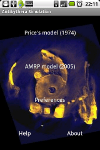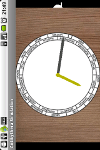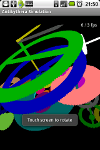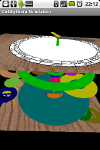

1. History
What is the Antikythera Mechanism?
The extraordinary "Antikythera Mechanism" is the oldest known complex scientific calculator,
and it was built in Ancient Greece.
Although it was built around 150-100BC it's degree of mechanical sophistication is
comparable to a 19th century Swiss clock.
It was discovered in 1900 an ancient mechanism was found by sponge divers at the bottom of the sea near the island of Antikythera. Though it's complexity was not yet acknowledged it astonished the whole international community of experts on the ancient world. 110 years of research and still we are not fully aware of the Antikythera Mechanism functionality, although we now know that it was used for astronomical measurements with extreme complexity and precision There is just too much that can be written about this extraordinary piece of ancient craftwork. The least I could do is gather a few reference links for further reading.
2. About the "Antikythera Mechanism 3D Simulation" app
This app is a 3D simulation of the 2 best known models, using OpenGLES 1.0 for 3D modelling.
Discover the capabilities of OpenGLES on Android smartphones.
List of models:
- The model of Brittish science historian Derek De Solla Price:
In 1974 and after 23 years of research he published a model of how the mechanism
could have functioned.
- The model of Antikythera Mechanism Research Project (AMRP):
A joint program between Cardiff University (M. Edmunds, T. Freeth), the National and
Kapodistrian University of Athens (X. Moussas, Y. Bitsakis), the Aristotle University of
Thessaloniki (J.H. Seiradakis), the National Archaeological Museum of Athens, X-Tek Systems UK[47]
and Hewlett-Packard USA, funded by the Leverhulme Trust and supported by the
Cultural Foundation of the National Bank of Greece.
These versions are preliminary ones, without much attention to the relative gear diameters or vertical positions. However, the tooth count of the gears and the operation are accurate.
Open Source
Antikythera Simulation android app is open source. You may find the project's source code at github
3. Controls
Rotate the mechanism, pinch zoom in and out and do lots of fun stuff to this high quality 3D model.
- Touch screen to rotate or pan (see "preferences"). Trackball is supported.
- Pinch with two fingers to zoom in / zoom out, or use the VolUp / VolDown keys.
- Toggle touch input to cause rotation or panning of the model by clicking the trackball,
DPAD center, or the camera button.
-Click MENU to show the Preference screen at any time.
Have fun!
5. Changelog.
v0.97 (01 Jul 2012) :
-Added a button to easily switch between pan and rotate modes.
-Open-sourced the project. You may find the source code at github.
v0.96 (18 Mar 2011) :
- Reformed FPS tag to display an average of last 10 frames, thus making it more accurate and consistent.
- Bugfix regarding pointer speed: Pointers rotate as they should.
- Tweaked a couple of gears that used to overlap.
- Every thread and process pause when screen is off or home button is pressed. Now the app should never run in background and consume your battery.
v0.95 (12 Feb 2011) : Android 1.6 support.
- Added support for android 1.6. (Multitouch not available in android < 2.0)
- Some calculations are written in a more efficient way causing 1-3% performance upgrade.
v0.94 (06 Feb 2011) : Minor bugfixes. Minor perfomance upgrade. About-Text enrichment.
- Added support for apps2SD.
- Fixed a bug which caused readings on the plates not to appear on certain devices running 2.1.
- Fixed a bug which sometimes caused plates to turn black after hiding the preferences menu.
- Added a brief explanation of the Mechanism's functionality in the "About" section.
- Better handling of memory usage.
- Minor perfomance increase when plates are hidden.
- Main screen buttons get coloured when pressed.
v0.93 (29 Dec 2010) : Initial release. Android version 2.1 and above supported.
6. Links / Further reading
- Home page of the Antikythera Mechanism Research Project (AMRP)
- The Antkythera Mechanism on Wikipedia
- Home Page of the original implementation written in C++. (works under any version of Windows, and in Linux using Wine)
- Interactive Relighting of the Antikythera Mechanism by HP
- A very good and brief explanation of some parts of the Mechanism
- A video documentary
- THE HEAVENS OF POSΕIDON, John Koulouris,(Esq.) in Greek only
- Παρουσίαση του Antikythera Simulation από το OSarena
- Project's source code hosted at github





